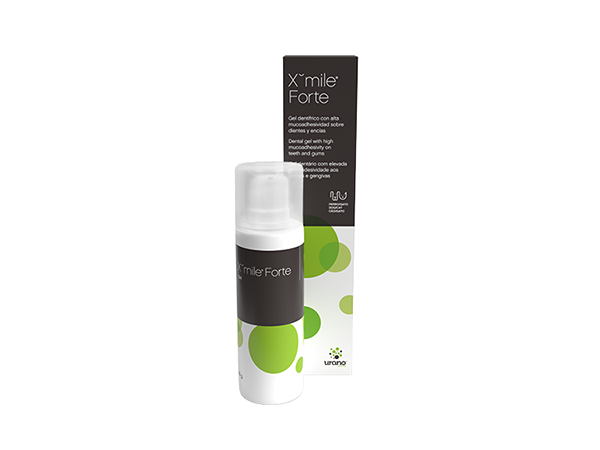
Oral hygiene
Xmile Forte
The new Xmile® Forte is a product formulated as an adjuvant for the daily care of gums with a tendency to inflammation in dogs and cats. The formulation is completed by, among others, phytosphingosine, which helps to regenerate, restructure and re-epithelialise damaged gums; hyaluronic acid, which helps to maintain optimal mucosal conditions; zinc gluconate, which promotes protection against pathogenic bacteria; and taurine, a chelator of sulphur derivatives, which in many cases are responsible for bad breath. It contains 20 percent ovoextract rich in natural IgY, preventing the appearance of dental plaque or tartar.
Its high mucoadhesivity to teeth and gums means it can be applied every 24 h. Apply Xmile® Forte ideally with a brush, although you can use it directly without.
Information for the veterinarian
| Phytosphingosine | Hyaluronic acid | Zinc gluconate |
|
Anti-biofilm and anti-erosion effect. Regeneration, restructuring and re-epithelisation of damaged gingiva. Formation of a diffusion barrier on tooth enamel. Increase in the hardness of the dental enamel. Anti-adherent effect of biofilm on gums and tooth enamel. |
Mediator for the regeneration of periodontal tissue. Very important in the granulation phase (promotes cell proliferation and migration of cells into the granulation tissue). |
Essential trace element (micronutrient). Cofactor necessary for cell membrane repair, cell proliferation, growth and immune system function. |

Dental hygiene and care is essential for maintaining the health of pets. That's why we work to raise awareness of its importance and for the prevention of oral diseases.
With the launch of the Xmile® line in 2014, we made an effort to contribute to putting oral hygiene in the hands of the veterinarian.
Xmile® is the most complete range of oral hygiene products for dogs and cats on the market, providing a set of high quality products designed to cover everything veterinarians and patients may need. Xmile® Gel, Xmile® Forte, Xmile® Depot and Xmile® Dental Sticks offer unique, innovative solutions for oral care and treatment.
In the study Detection of putative periodontal pathogens in subgingival specimens of dogs, published in The Brazilian Journal of Microbiology (2007), PCR analysis of gingival tissue samples obtained from 40 dogs (25 with periodontal disease and 15 with no signs of disease) found the following bacteria populations in samples with periodontal disease:
- 64 % Porphyromonas gingivalis
- 36 % Campylobacter rectus
- 24 % Actinobacillus actinomycetemcomitans
- 20 % Prevotella intermedia
- 20 % Tannerella forsythensis
- 16 % Fusobacterium nucleatum
The prevalence of Porphyromonas gingivalis in samples from animals without periodontal disease was only 6.66%.
In short, dental plaque is the community of bacteria that for a biofilm, embedded in a matrix. This makes them much more resistant to the action of antibiotics and antiseptics.
The antibacterial properties of saliva are an important factor in the oral defence system. This protective effect can be further improved with the regular use of tooth gels containing enzymes and other active ingredients that enhance the natural protection provided by saliva.
Source: Visual atlas of oral pathologies, 2016. ISBN: 978-84-16315-77-2. Editorial Servet, Grupo Asís.
DOCUMENTATION FOR THE VETERINARY
* This information is available only to veterinarians. Clicking the download link declares that possess appropriate qualifications to access the content..

